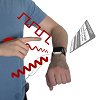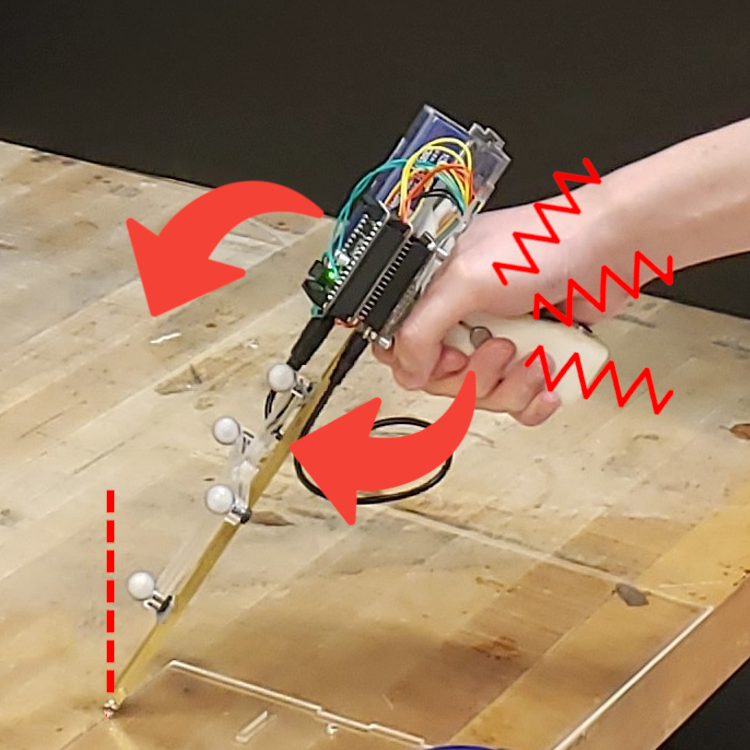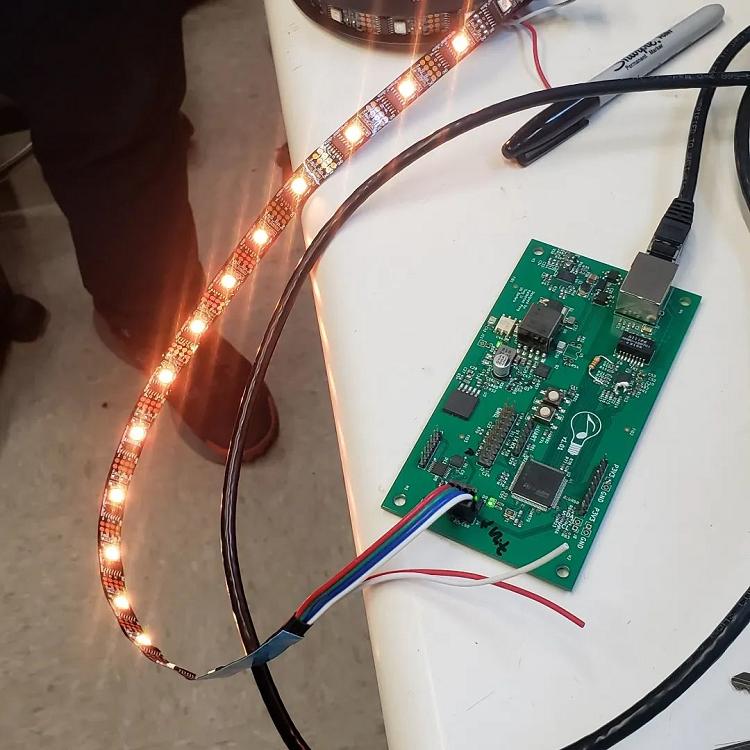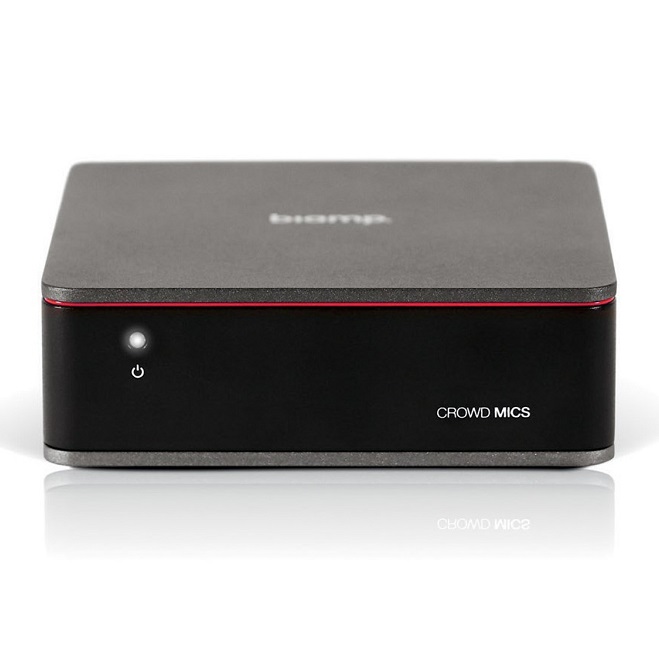Jan
|
Curriculum Vitae
|
[Demo] Active Haptic Feedback for a Virtual Wrist-Anchored User Interface |
||
| Jan Ulrich Bartels, Natalia Sanchez-Tamayo, Michael Sedlmair, Katherine J. Kuchenbecker | ||

|
Mobile computing devices often feature small interaction surfaces but advances in Augmented/Virtual Reality might allow us soon to anchor and interact with digital interfaces in the space surrounding our bodies. With the loss of a physical surface, however, also comes the loss of haptic feedback, an important dimension in user interaction. To restore haptic sensation, many approaches focus on having the user interact with their own skin but this approach does not capture the rich tactile experience of interacting with common UI elements, such as buttons and sliders. To address this, our demo combines a novel wrist-worn haptic device with a virtual, wrist-anchored UI to show how haptic feedback can be conveniently added to body-anchored UI interactions. This work was presented at ACM UIST 2024. |
|
[Demo] 3D Hapkit: A Low-Cost, Open-Source, 3-DOF Haptic Device Based on the Delta Parallel Mechanism |
||
| Han Zhang, Jan Ulrich Bartels, Jeremy D. Brown | ||

|
New generations of haptic interface designers need exposure to haptic devices during their studies, but commercial products are often too complicated and cost prohibitive to deploy in a classroom setting. To address this, Martinez et al introduced the Hapkit, an open source 1-DOF haptic device, and the Graphkit, an open source 2-DOF haptic device based on 2 Hapkits in 2017. This project extends the capabilities of open-source, low-cost haptic devices by yet another dimension by combining three Hapkits using the delta-parallel mechanism into the 3DHapkit. At under $300, and comprised of 3D printed and laser-cut parts, the 3DHapkit enables students to experiment with and make modifications to a 3D haptic device. This work was presented at the IEEE World Haptics Conference in 2023. |
|
[Paper] Towards Reducing Visual Workload in Surgical Navigation: Proof-of-Concept of an Augmented Reality Haptic Guidance System |
||
| Gesiren Zhang, Jan Ulrich Bartels, Alejandro Martin-Gomez, Mehran Armand | ||

|
This study explores the integration of haptic feedback into a surgical tool handle to enhance surgical guidance without overloading the visual field allowing surgeons to maintain focus on the surgical site. In a pilot study with six participants, tasks such as tracing, pinpointing, and alignment were completed using a haptic-enabled tool. Results demonstrated high accuracy, with participants achieving sub-millimeter and sub-degree precision: 0.82mm in location matching, 0.83° in alignment, and 0.46° in rotation, with minimal training required. This work was published at Computer Methods in Biomechanics and Biomedical Engineering: Imaging & Visualization, a AE-CAI 2022 Workshop. |
|
[Project] HoloStylus: Handheld Skin-Stretch Pen for Ungrounded Augmented Reality Interactions |
||
| Jan Ulrich Bartels, Gesiren Zhang, Ulas Berk Karli, Kapi Ketan Mehta | ||

|
Schorr et al have shown in 2013 that cutaneous skin-stretch can effectively augment human stiffness perception in a grounded haptic device. For our semester project for Haptic Interface Design we wanted to see if this same modality could be leveraged in an ungrounded application. Our project combined a Microsoft HoloLens with a novel, ungrounded, haptic pen with two skin-stretch pads. A demo at the end of the semester showed that combining visual and haptic feedback could effectively render the sensation of interacting with a soft object in mid-air. |
|
[Project] Polaris: A PoE+ Powered, Artnet Capable, Board for Scalable Lighting Projects |
||
| Jan Ulrich Bartels, Katherine Peng, Ting Li | ||

|
I love tinkering with smart LEDs and have been taking on a growing list of lighting projects. One big issue, however, is the persistent need to transfer power and data using separate cables which, I find, creates a lot of visual clutter. To address this I developed the idea of an embedded system that could accept power as well as data over ethernet using the IEEE PoE+ standard. To realize this project, I mentored two JHU Electrical Engineering undergraduates whom I taught the basics of embedded systems design and who designed this circuit for me. |
|
[Project] Rainbow Totems: A mobile infinity mirror and rainbow cloud with animations for EDM festivals | ||
| Jan Ulrich Bartels | ||

|
EDM festivals have a thriving culture of totems, visually identifiable items, often placed on tall sticks, that help members of a group remain together. Totems are also a great way to meet new people, especially if the totem has some interesting feature. To contribute to this culture, I thus designed and built two animated LED totems for my 2017-2018 festival trips. Both were powered by commercially available 5V USB power banks and run off either an Atmega328 or an Attiny85 with some buttons and sliders attached to change the animations. |
|
[Industry] CrowdMics Atom Differential Output Card |
||
| Biamp Systems | ||

|
Designed a USB to differential analog output stage and performed extensive ESD testing to debug grounding issues in early prototypes. |
|
[Industry] TesiraXEL 1200.1/1200.2 |
||
| Biamp Systems | ||

|
TesiraXEL was a new series of smart audio amplifiers whose core feature was that they allowed users to allocate power from a shared pool across 4 channels. I was responsible for designing the power rails for the host processor, migrating the analog output stages from PADS to Altium, hardware bringup and EMF compliance testing. |
|
[Industry] Tesira Forte Dan |
||
| Biamp Systems | ||

|
Tesira Forte Dan complemented Biamp's AVB product line with a Forte that could receive audio data using the Audinate Dante format. My role was to replace the FPGA, which had been handling AVB traffic, with Audinate's Dante Brooklyn II module. |
|
| © Jan Ulrich Bartels |